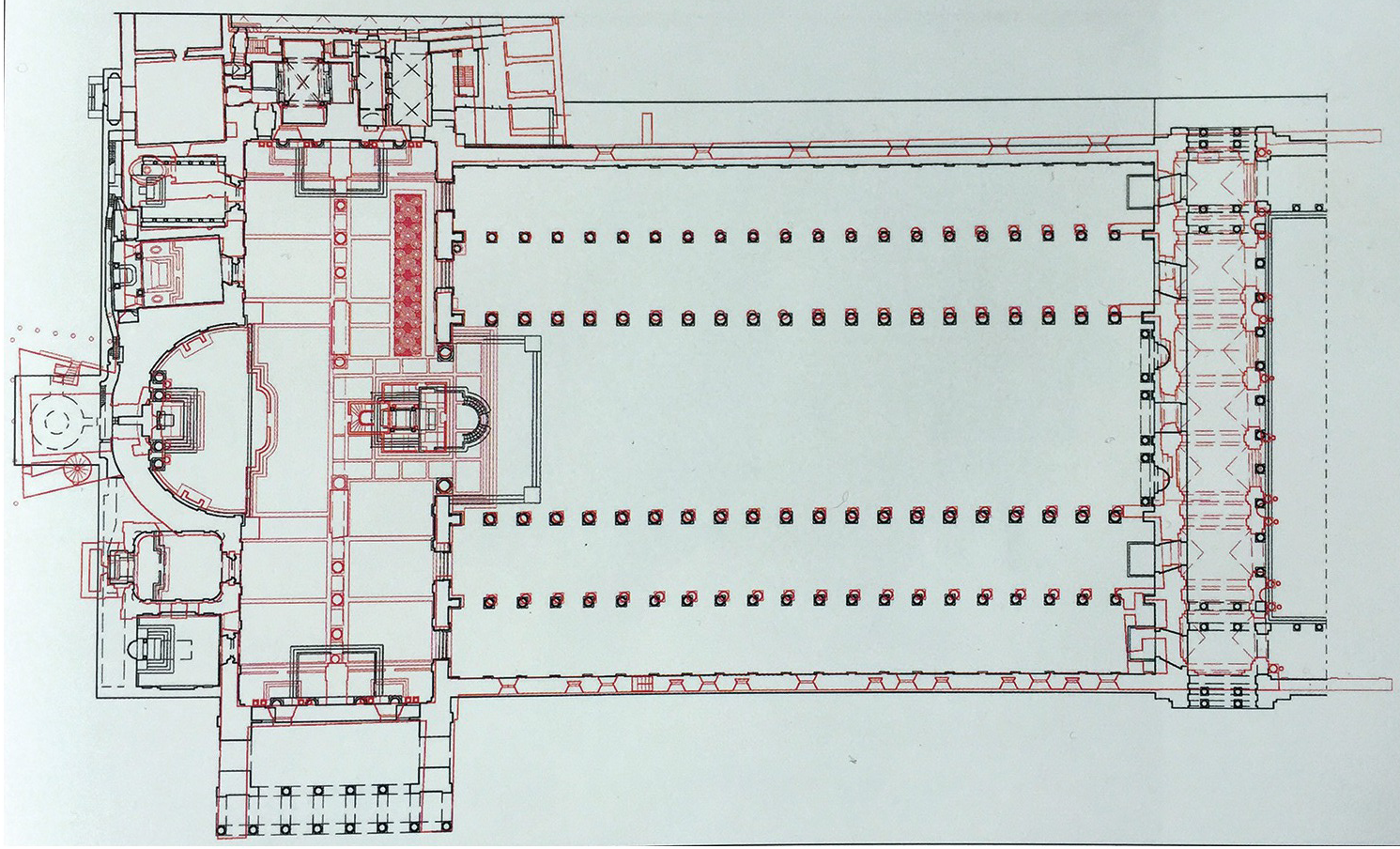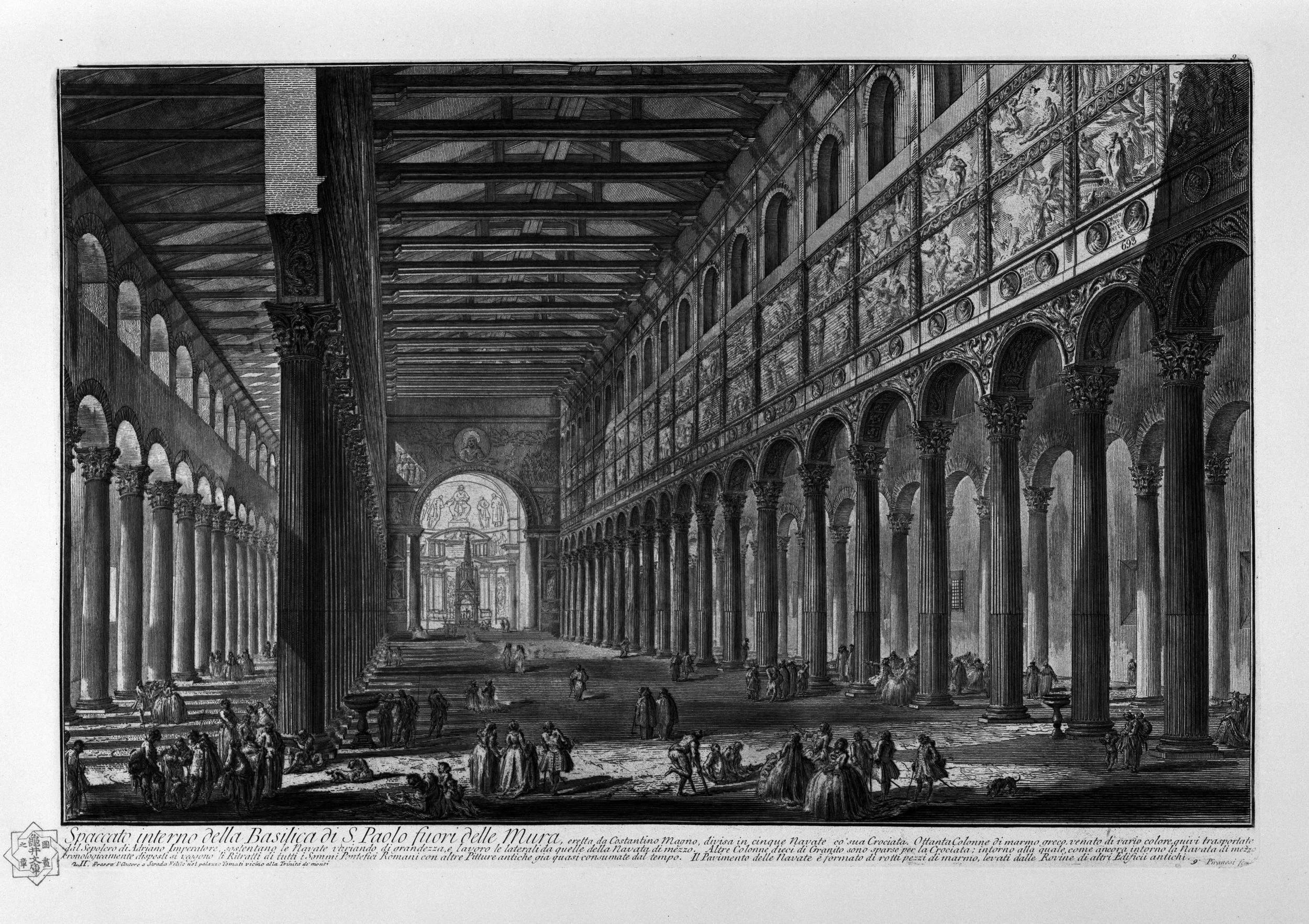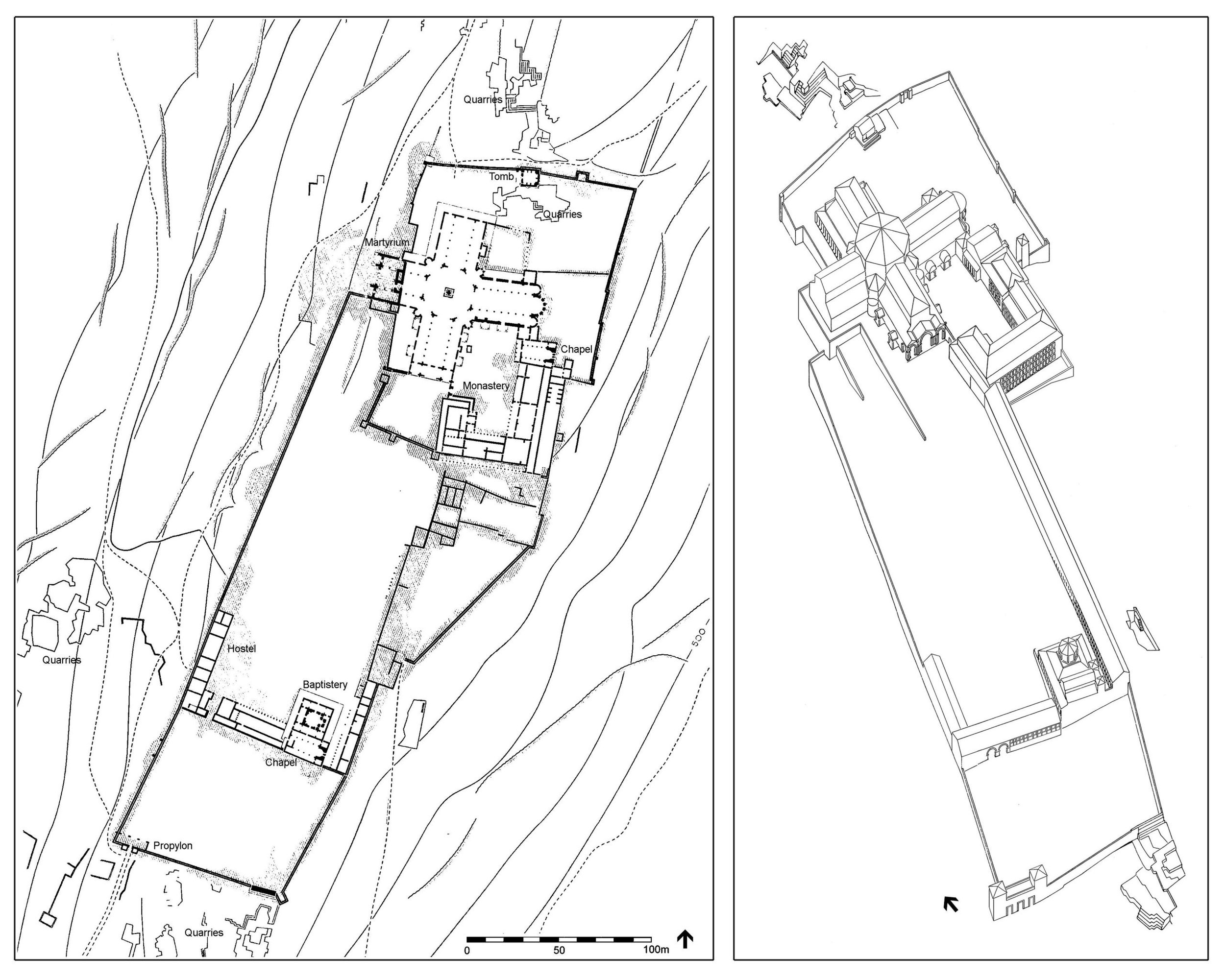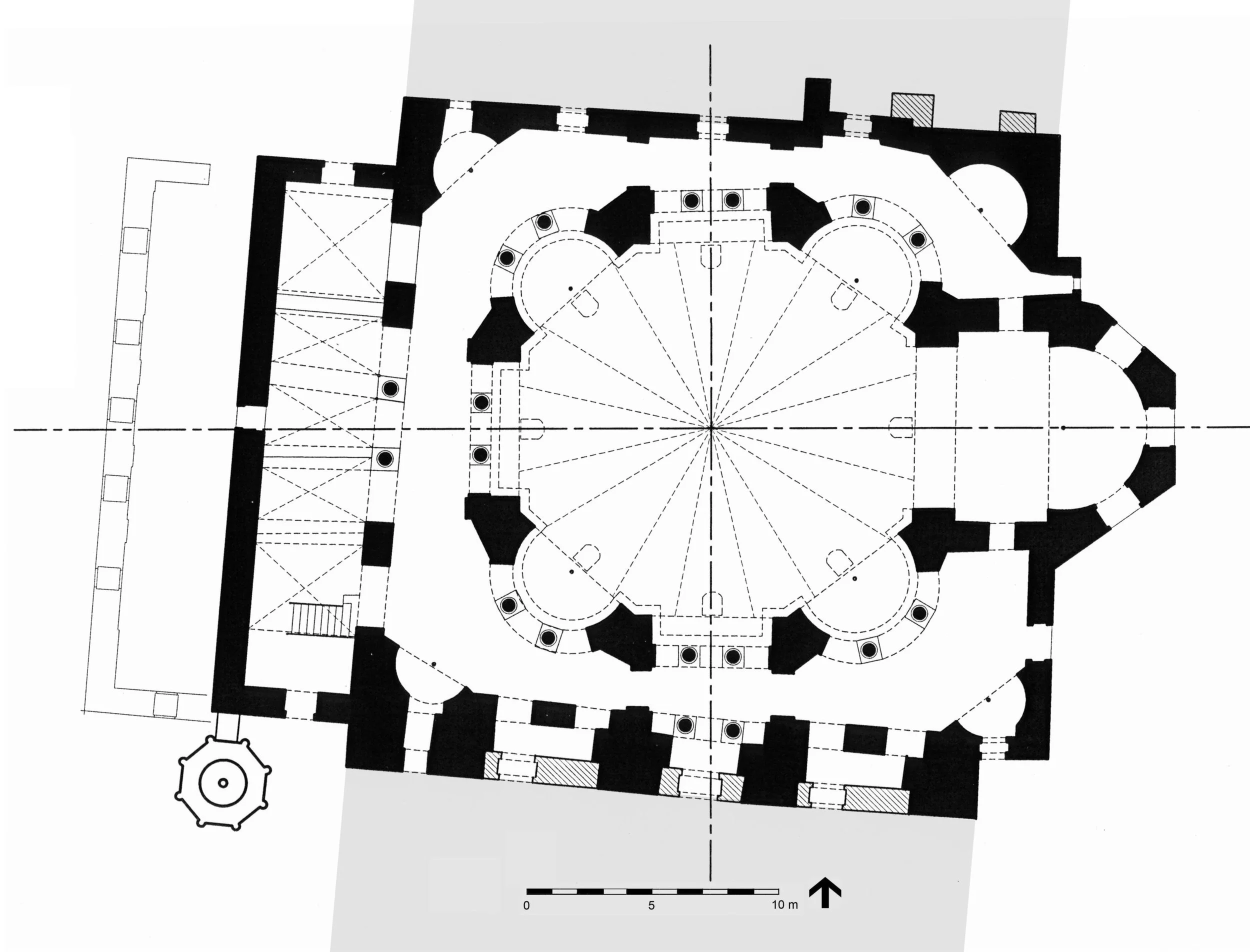Constantinian basilicas of St. Peter and at the Lateran, alongside the Theodosian basilica of St. Paul
Basilicas and new forms
After the time of Constantine, the Roman emperor who ruled from 306–337 C.E., a standardized church architecture emerged, with the basilica for congregational worship dominating construction. The basilica is a church type based on Roman assembly halls, usually composed of a longitudinal nave flanked by side aisles.
Formally, the basilica also stood in sharp contrast to the pagan temple, at which worship was conducted out of doors. The church basilica was essentially a meeting house, not a sacred structure, but a sacred presence was created by the congregation joining in common prayer—the people, not the building, comprised the ekklesia (the Greek word for “church”).
The Lateran basilica, originally dedicated to Christ, was begun c. 313 to serve as Rome’s cathedral, built on the grounds of an imperial palace, donated to be the residence of the bishop. Five-aisled in plan, the basilica’s tall nave (the central aisle of a basilica) was illuminated by clerestory windows, which rose above coupled side aisles along the flanks and terminated in an apse (a semicircular recess containing the altar) at the west end, which held seats for the clergy. Before the apse, the altar was surrounded by a silver enclosure, decorated with statues of Christ and the Apostles.
Restored plan and hypothetical section, church of the Holy Sepulchre, c. 350 C.E.—In addition to congregational churches, among which the Lateran stands at the forefront, a second type of basilica (or ambulatory basilica) appeared in Rome at the same time, set within the cemeteries outside the city walls, apparently associated with the venerated graves of martyrs. S. Sebastiano, probably originally the Basilica Apostolorum, which may have been begun immediately before the Peace of the Church (the toleration of Christianity following the Edict of Milan), rose on the site of the earlier triclia, in which graffiti testify to the special veneration of Peter and Paul at the site. These so-called cemetery basilicas provided a setting for commemorative funeral banquets. Essentially covered burial grounds, the floors of the basilicas were paved with graves and their walls enveloped by mausolea.
Santa Sabina, Rome, 522–532
There were numerous regional variations: in Rome and the West, for example, basilicas usually were elongated without galleries, as at S. Sabina in Rome (522–32) or S. Apollinare Nuovo in Ravenna (c. 490). In the East the buildings were more compact and galleries were more common, as at St. John Stoudios in Constantinople (458) or the Achieropoiitos in Thessaloniki (early fifth century).
St. John Stoudios, 458, Constantinople
By the fifth century, the liturgy had become standardized, but, again, with some regional variations, evident in the planning and furnishing of basilicas. In general, the area of the altar was enclosed by a templon barrier (a screen separating the nave or naos from the sanctuary, also called a chancel barrier), with semicircular seating for the officiants (the synthronon) in the curvature of the apse (a semicircular recess, usually terminating the longitudinal axis of a church, containing the altar). The altar itself was covered by a ciborium, a canopy raised above an altar, throne, or tomb (also called a baldachin). Within the nave, a raised pulpit or ambo provided a setting for the Gospel readings.
The liturgy probably had less effect on the creation of new architectural designs than on the increasing symbolism and sanctification of the church building. Some new building types emerge, such as the cruciform (cross-shaped) church, the tetraconch (a building with four apses), octagon (eight-sided shape), and a variety of centrally planned structures.
Such forms may have had symbolic overtones. For example, the cruciform plan may be either a reflection of the church of the Holy Apostles in Constantinople (a nonextant cruciform church of Constantinople first built by Constantine’s sons and rebuilt in the sixth century under emperor Justinian I that contained relics of some of the Apostles and incorporated mausolea where Byzantine emperors were buried until 1028) or associated with the life-giving cross, as at S. Croce in Ravenna or SS. Apostoli in Milan. Other innovative designs may have had their origins in architectural geometry, such as the enigmatic S. Stefano Rotondo (468–83) in Rome.
The aisled tetraconch churches, once thought to be a form associated with martyria (tomb of a martyr or a site that bears witness to the Christian faith), are most likely cathedrals or metropolitan churches. The early fifth-century tetraconch in the Library of Hadrian in Athens was probably the first cathedral of the city; that at Selucia Pieria-Antioch, from the late fifth century, was possibly a metropolitan church.
Santo Stefano Rotondo, Rome, c. 468–83
Lateran Baptistery in Rome, reconstruction, 1550s
Baptisteries, buildings containing a font for Christian initiation, are also prominent throughout the Empire, necessary for the elaborate ceremonies addressed to adult converts and catechumens. Most common was a symbolically resonant, octagonal building housing the font and attached to the cathedral, as with the Orthodox (or Neonian) Baptistery at Ravenna, c. 400–450. In Rome, the Lateran’s baptistery was an independent, octagonal structure that stood north of the basilica’s apse. Built under Constantine, the baptistery expanded under Pope Sixtus III in the fifth century with the addition of an ambulatory around its central structure.
Associated with death and resurrection, the planning type derives from Late Roman mausolea (a monumental building for burial), although not directly from the Anastasis Rotunda (a circular structure enclosing Christ’s Tomb at the church of the Holy Sepulchre in Jerusalem). Variations abound: at Butrint (in modern Albania) and Nocera (in southwestern Italy), for example, the baptisteries have ambulatories; in North Africa, the architecture tends to remain simple, while the form of the font is elaborated. With the change to infant baptism and a simplified ceremony, however, monumental baptisteries cease to be constructed after the sixth century.
Martyria and Mausolea
Although the church gradually eliminated the great funeral banquets at the graves of martyrs, the cult of martyrs was manifest in other ways, notably the importance of pilgrimage and the dissemination of relics (remains of saints or objects considered holy because they touched the bodies of saints). In spite of this, there was not a standard architectural form for the martyria, which instead seem to depend on site-specific conditions or regional developments.
1- In Rome, for example, S. Paolo fuori le mura (St. Paul Outside the Walls), begun 384, follows the model of St. Peter’s in adding a transept to a huge five-aisled basilica. 2- At Thessaloniki, the basilica of H. Demetrios (late fifth century) incorporated the remains of a crypt and other structures associated with the Roman bath where Demetrius was martyred. 3- At rural locations, large complexes emerged, as at Qal’at Sem’an, built c. 480–90 in Syria, which had four basilicas radiating from an octagonal core, where the stylite saint’s column stood. Stylite saints lived atop pillars (stylos is Greek for “pillar”) as a means of self denial. 4- At Hierapolis in Asia Minor, a large octagonal complex was built at the site of the tomb of St. Philip. 5- At Ephesus, a cruciform church arose at the tomb of St. John the Evangelist. 6- At the martyrium of St. Thekla at Meryemlik, c. 480, a three-aisled basilica was added above her holy cave. 7- At Sinai, the sixth-century basilica was augmented by subsidiary chapels along its sides, but the holy site—the Burning Bush, believed to be the bush through which God revealed himself to Moses, lay outside, immediately to the east of its apse.
S. Paolo fuori le mura, Rome, begun 384.
Plan and reconstruction of Qal’at Sem’an
Martyrium and burial church complex of St. Philip, Hierapolis
The desire for privileged burial perpetuated the tradition of Late Antique mausolea, which were often octagonal or centrally planned. In Rome the fourth-century mausolea of Helena (mother of emperor Constantine) and Constantina (the daughter of emperor Constantine) were attached to cemetery basilicas. Cruciform chapels seem to be a new creation, with a shape that derived its meaning from the life-giving Cross, a relationship emphasized in the well-preserved Mausoleum of Galla Placidia, built c. 425, in Ravenna, which was originally attached to a cruciform church dedicated to S. Croce.
In Jerusalem and Athens, there may have been an intentional visual juxtaposition of the new Christian cathedral with the abandoned Jewish or pagan temple. While the Theodosian Code (a collection of Roman law issued in 438 by Theodosius II and Valentinian III) legislated the cessation of pagan worship, it recommended the preservation of the temple building and its contents because of their artistic value. The transformation of temples into churches was rare before the sixth century.
Rome, Sant’Agnese site plan: cemetery basilica with attached Mausoleum of Constantina (S. Costanza); medieval Basilica of Sant’Agnese above the catacombs.
Urban Planning
Monasticism began to play an increasingly important role in society, but from the perspective of architecture, early monasteries lacked systematic planning and were dependent on site-specific conditions. The coenobitical system (communal monasticism) included living quarters, with cells for the monks, as well as a refectory for common dining and a church or chapel for common worship. Evidence is preserved in the desert communities of Egypt and Palestine. At the Red Monastery at Sohag, the formal spaces are contained within a fortress-like complex, although it is unclear where with or without the enclosure the monks actually lived. In the Judean Desert, a variety of hermits’ cells are preserved—simple caves carved into the rough landscape.
In general, urban planning in this period follows Roman and Hellenistic models. 1- Justinian’s new city of Iustiniana Prima (Caracin Grad, in modern Serbia), 2- Gerasa (Jerash).
Defensive architecture followed Roman practices.
The walls of Constantinople, added by Theodosius II (412–13) stand as a singular achievement, combining two lines of defensive walls with a moat. In a like manner, the system of aqueducts and cisterns at Constantinople expanded upon established Roman technology to create the most extensive water system in Antiquity.
Standard planning continued in domestic architecture as well. Large houses excavated in Asia Minor (Sardis, Ephesus), North Africa (Carthage, Spaitla, Apollonia), Italy (Ravenna, Piazza Armerina), Greece (Athens, Argos), and elsewhere include porticoed gardens, audience halls, and triclinia (dining rooms). The Great Palace in Constantinople and the so-called Palace of Theodoric in Ravenna were essentially elaborations on or repetitions of the Late Roman villa. Perhaps the most significant changes in the Late Antique domus (house) were the increasing size and number of ceremonial spaces (audience halls and triclinia)—as at the early fourth century villa at Piazza Armerina (in Sicily)—and the incorporation of chapels into the domestic setting—as at the Palace of the Dux at Apollonia (in modern Libya). The latter phenomenon is indicative of the growing importance of private worship and was a source of growing concern in ecclesiastical legislation. With significant economic and social changes, however, by the end of the period under discussion, the domus disappeared.
Caričin Grad (Iustiniana Prima) site plan, with detail of the acropolis
Gerasa (Jerash), plan of the city with a detail of the Cathedral complex
Constantinople, plan of the fifth century city
Plan of villa, Piazza Armerina
Innovative architecture in the age of Justinian
Although standardized church basilicas continued to be constructed, by the end of the fifth century, two important trends emerge in church architecture: the centralized plan, into which a longitudinal axis is introduced, and the longitudinal plan, into which a centralizing element is introduced.
The first type may be represented by the church of the Theotokos on Mt. Garizim (in modern Israel), c. 484, which has a developed sanctuary bay projecting beyond an aisled octagon with radiating chapels; the second by the so-called Domed Basilica at Meriamlik (on the southern coast of Turkey), c. 471-94, which superimposed a dome on a standard basilican nave. Both may be attributed to the patronage of emperor Zeno (reigned 474–91).
Both trends are further developed during the reign of Justinian (reigned 527 to 565). HH. Sergios and Bakchos in Constantinople, completed before 536, and S. Vitale in Ravenna, completed c. 546/48, for example, are double-shelled octagons of increasing geometric sophistication, with domes covering their central spaces, perhaps originally combined with wooden roofs for the side aisles and galleries.
Byzantine architecture then, though rooted in Roman traditions, developed its own style characterized by features like octagonal plans, domed roofs, and elaborate mosaic decorations, which would influence later structures like the Hagia Sophia. Justinian's reign is characterized by the rise of Byzantine architecture, exemplified by the Church of San Vitale in Ravenna, Italy.
San Vitale, built in the 6th century, represents a significant development in early Byzantine architecture / and a departure from the traditional basilica form. as it is an octagonal church with a central dome.
Sts. Sergius and Bacchus (Küçük Ayasofya Camii), Constantinople (Istanbul), completed before 536
S. Vitale in Ravenna, completed c. 546/48
…………………..Several monumental basilicas of the period included domes and vaulting throughout, most notably at Hagia Sophia, built 532-37.…….Hagia Sophia combines elements of the central plan and the basilica on an unprecedented scale. Its unique design focused on a daring central dome of slightly more than 100 feet in diameter, raised above pendentives, and braced to the east and west by half-domes. The aisles and galleries are screened by colonnades with exedrae (semicircular recesses) at the corners………
……………..The spatial unit formed by the dome on pendentives could also be used as a design module, as at Justinian’s rebuilding of the church of the Holy Apostles in Constantinople, in which five domes covered the building. A similar design was employed in the rebuilding of St. John’s basilica at Ephesus, completed before 565, which because of its elongated nave took on a six-domed design. The late eleventh-century S. Marco in Venice follows this sixth-century scheme…………
St. John’s basilica at Ephesus
…………….The Basilica of San Marcos is the third built over the years in the same place………..the third and final reconstruction of the church began in 1063 and when finally consecrated in 1094, had five low domes, was rich in columns, cornices and capitals brought from Constantinople……….in 1177 the Doge Sebastiano Ziani ordered the construction of a terrace on the main façade and expand the atrium west………...
In spite of design innovations, traditional architecture continued in the sixth century with the wooden roofed basilica continuing as the standard church type. At St. Catherine’s on Mt. Sinai, built c. 540, the church preserves its wooden roof and much of its decoration. The three-aisled plan incorporated numerous subsidiary chapels flanking the aisles. At the sixth-century Cathedral of Caricin Grad, the three-aisled basilica included a vaulted sanctuary area, with the earliest securely dated example of pastophoria: apsed chapels—known as the prothesis and diakonikon—which flanked the central altar area to form a tripartite sanctuary. This tripartite form that would become standard in later centuries.
Given the importance of Hagia Sophia, domed churches types will predominate during the subsequent period and will tend to follow in simplified form the grand developments of the age of Justinian. A period of economic downturn and loss of territory led to a decrease in pan-Mediterranean trade, a reduction in the size of cities, and a social and economic shift from urban to rural. Public ceremonies, which often incorporated the emperor and church officials—a hallmark of previous centuries—also declined, and the Byzantine liturgy became more interior, with fewer outdoor processions. Churches became smaller and more centralized, accommodating smaller congregations and a more static liturgy. In general, the decrease in the scale of church construction led to the development of new, simpler architectural designs.
H. Sophia in Thessalonikie for example, built less than a century later than its namesake, is both considerably smaller and heavier, as is the Koimesis church at Nicaea. Both correct the basic problems in the structural design by including broad arches to brace the dome on all four sides.
In the Caucasus, Georgia and Armenia witness a flourishing of architecture in the seventh century, with numerous, distinctive, centrally planned, domed buildings, constructed of rubble faced with a fine ashlar, although their relationship with Byzantine architectural developments remains to be clarified. The domed church of St. Hripsime at Vagarshapat has a dome rising above eight supports, set within a rectangular building. The church at Church of the Cross at Jvari is similar, but with its lateral apses projecting. The aisled tetraconch church of Zvartnots stands out as following Byzantine, particularly Syrian, models.
………………From a practical point of view, churches of different scales demanded different structural systems. For smaller churches, galleries (the upper level in a church) and ambulatories (a passage around a central space) were unnecessary and internal supports could be reduced to columns. The domed basilica provided sufficient space for a larger congregation. The cross-domed church offered an effective structural design for an intermediate congregation. The cross-in-square was ideal for smaller churches with a dome fewer than 20 Byzantine feet in diameter. It was this smaller church type that became popular in the centuries following iconoclasm……………..
St. Hripsime, Vagarshapat
Church of the Vigilant Powers (Zvart‘nots‘), Vagarshapat, plan and possible reconstructed elevation, from Josef Strzygowski, Die Baukunst der Armenier und Europa, vol. 1 (Vienna: A. Schroll & Co., 1918), figs. 112 and 119.









































